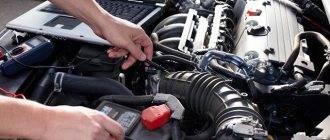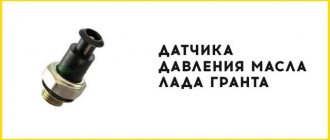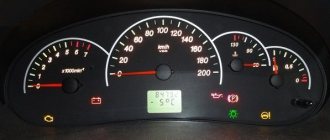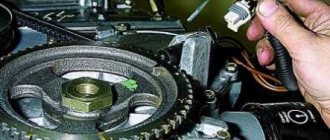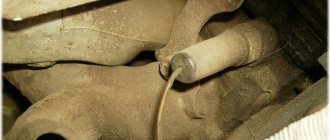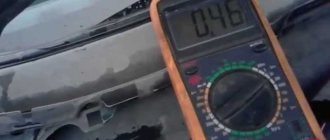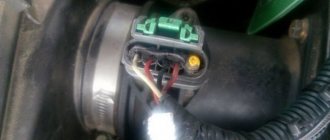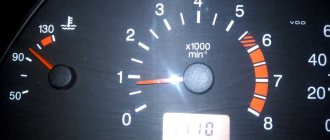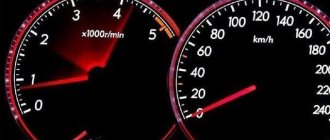Which sensor is responsible for engine speed? List and necessary information
If problems arise with the engine, you may be asked which sensor is responsible for engine speed.
Often it is these electronic devices that drivers are guilty of in the first place. But the sensors should be checked last. The speed can fluctuate for a variety of reasons. First you should make sure there are no other damage. Often problems with speed begin after refueling with low quality fuel.
In this case, the injection system is simply not able to produce a normal mixture.
Idle speed sensor
It should be noted that if it is damaged, the speed will float mainly at idle. But in any case, the check should begin with DXX. To do this, you need to remove the wire block from the sensor. Then the voltage is checked. To do this, one terminal of the wires is connected to ground, that is, applied to the engine. The second wire is connected to the sensor and the voltage is measured.
The multimeter must output a voltage of at least 12V. If the indicator is lower, then the battery may be low. After its charge is restored, engine operation may be restored. You also need to check the resistance at the terminals, it should be 53 ohms. Measurements must be made on paired contacts. You need to change the sensor if the resistance is lower or higher.
Conclusion
According to the design features of the engine, power units are equipped with a large number of sensors that affect engine starting. The indicators that influence the start of the power unit include: fuel quality, detonation, crankshaft, phases, throttle position of the idle speed control, mass flow of air, oxygen and coolant temperature.
Thus, the output of one or more indicators can radically affect the starting and operation of the engine.
On throttle position
This sensor is designed for the controller to calculate the throttle opening level. It is installed on the throttle axis. When you press the accelerator pedal, it turns along with the throttle. Essentially, this is a variable resistor that, depending on the angle of rotation, changes the voltage level supplied to the controller.
It is checked this way. The ignition is turned on and the voltage at the sensor terminals is measured. It should fluctuate from 0 V at the starting position, to 12 V at the maximum. You can also measure resistance, but this is not necessary. If the voltage is absent or increases unstably, then the TPS is faulty and needs to be replaced.
Mass air flow sensor
This sensor controls and normalizes the flow of air into the fuel mixture. Signs of its malfunction are the following problems:
- Unstable speed;
- Problems starting a warm engine;
- Reduced power.
This sensor is checked in different ways. The simplest of them is to turn off the mass air flow sensor and drive without it. If the negative aspects disappear, then most likely the reason is in the sensor. Also, sensor failure can be caused by poor-quality firmware. To do this, place a 1 mm thick plate under the throttle valve stop. At the same time, the speed should increase slightly. Then remove the chip from the sensor we are interested in. If the engine continues to run, the reason is the “crooked” firmware.
The test is also performed by measuring the voltage. To do this, take a multimeter; it should be set to a maximum voltage of 2 V. Next, measure the voltage at the terminals. On a new, fully operational sensor, it should fluctuate between 0.98-1.01 V. A malfunction of the mass air flow sensor is indicated by a voltage of more than 1.05 V. In this case, it should be replaced.
Knock sensor (DS)
The purpose of the device is to detect knocking noises in the power unit due to severe detonation. As a rule, the DD is mounted in the engine block between the 2nd and 3rd cylinders.
There are two types of such devices used in cars today. They come in broadband and resonant types.
The former monitor and detect waves in the range of 6-15 kHz, and the latter respond to audio frequency.
Note that resonant DDs are almost never used, and they can be found on old cars.
The information received is collected and transmitted to the machine's ECU. When detonation is detected, the ignition angle is shifted to remove negative consequences.
A malfunction of the DD can be identified by the following signs:
- deterioration of the dynamic parameters of the car, for example, difficulty climbing uphill;
- “swimming” XX;
- instability in the operating mode;
- increase in fuel consumption.
The reasons for the failure of the DD include:
- problems with the ECU in the form of software failures;
- deterioration of contact at the junction;
- burnout of gasket under DD;
- violation of wiring integrity: break, short circuit;
- sensor damage;
- deterioration of contact between the motor block and the motor housing.
You can use different methods to test the sensor. The most common is measuring the voltage at the terminals, which when exposed to the device should reach 20-30 mV.
You can measure the resistance, which in a quiet state is about 500 kOhm, and when tapped it rises to 1-2 kOhm. More complex options are the use of a diagnostic scanner or oscilloscope.
Also read - why the engine knocks.
Camshaft position sensor (CPR)
Works based on the Hall effect. Another name is phase sensor. Like DPKV, it controls the camshaft angle and sends the collected data to the ECU.
The latter compares them with the crankshaft angle and, after processing them, decides on the need to open the fuel injectors at a certain period of time.
It is located in the area of the first cylinder near the camshaft pulley.
On engines of old cars produced before 2005, DPRV was not installed, which is why fuel was supplied to the intake manifold in pairs-parallel mode. Two injectors supplied the fuel mixture simultaneously, which caused an increase in consumption.
On engines with DPRV, phase injection is provided. The peculiarity is that only one nozzle opens, through which fuel is supplied. The installation location on 8-valve engines is the cylinder head near the 1st cylinder.
Signs of a DPRV failure include:
- transferring the engine to emergency mode with paired opening of the injectors;
- tripling of the power unit;
- issuing an error on the “tidy” in the form of Check Engine (P0340/0341/0342/0343/0339);
- increased fuel consumption;
- locking the gearbox at one speed (usually 1st);
- jerks when moving;
- popping sounds in the exhaust system;
- loss of spark, difficulty starting the power unit;
- When starting the engine, the starter runs at idle for the first 3-4 seconds, and only after that does it start.
- problems with acceleration when reaching 60 km/h;
- The engine starts and immediately stalls at idle.
There can be many reasons for the breakdown of the DPRV, so let’s highlight the main ones:
- wear due to long-term use, this occurs due to constant exposure to high temperatures and vibrations.
- short circuit to the body;
- moisture in the connector;
- presence of chips on the DPRV body;
- breakage of the signal wire sheath;
- blown fuse through which the DF is powered;
- breakdown of high-voltage ignition circuits;
- ECU failure;
- network short circuit;
- incorrect connection.
To check, measure the voltage between the body and the signal wire. It should be +12 V.
Also check the resistance. The normal value is from 500 to 1000 Ohms (maybe 1-2 kOhms). Also check the insulation, the presence of ground and the integrity of the insulation.
Auto engine speed sensor
When car enthusiasts have certain problems with the engine, they begin to wonder which sensor is responsible for engine speed, since the first suspicion often falls on these devices.
However, this is not always the case, because the speed can “float” for various reasons. It is best to first make sure that there are no other damage, and check the meters afterwards. One way or another, if you want to locate the sensor you need, you need to know what it looks like and where to look for it.
Basic Concepts
To synchronize the operation of the ignition systems, as well as injection, a speed sensor is provided, or, as it is called, a speed meter. It is he who transmits to the electrical unit that controls the engine the necessary data about what rotations the crankshaft is currently supporting.
This power unit meter is the most important element of the car, without which the interaction of many systems is essential, because it helps ensure the correct functioning of the entire car as a whole.
The car's electronic control unit processes the special signals that this meter sends to find out:
- amount of fuel injected at the moment;
- injection moment;
- time required to activate the adsorber valve;
- ignition timing (for gasoline engines);
- the angle of rotation of the camshaft during operation of the system to change the phases of the gas distribution mechanism.
To determine the performance of the meter, you need to know its location.
Intake manifold pressure sensor (MAP Sensor)
The Manifold Air Pressure Sensor, MAP sensor, is another element that is used in the electronic engine management system. This sensor measures the pressure of the intake air. Typically the sensor is mounted on the intake manifold and is usually integrated with the intake air mass flow sensor. Some car models use a single sensor that measures both the amount of air intake and its pressure.
What function does the sensor perform: determines the absolute air pressure in the intake manifold. The sensor then converts the data into a voltage signal and sends it to the engine control unit (ECU). The car's computer controls the required amount of fuel injection based on the voltage of this signal coming from the sensor.
Symptoms: If the intake air pressure sensor is faulty, the amount of fuel injected into the engine cannot be adjusted correctly, causing the fuel mixture to become too rich or too lean, causing the engine to run abnormally. In this case, the engine will operate unstable at idle (the speed will jump). The engine may also stall frequently. In addition, there may be problems with its launch. And, of course, if this sensor malfunctions, fuel consumption will increase significantly, despite the fact that the car’s power, as a rule, will drop.
If this sensor fails, a “Check Engine” indicator may appear on the dashboard.
see also
Symptoms of a Malfunctioning Camshaft Sensor
Location
The speed sensor, or induction meter, is usually located above the vehicle's marker disc.
The disk, in turn, may be located:
- on the flywheel;
- on the crankshaft inside the cylinder block - this happens with brands Ford, Opel, etc.;
- in front of the engine compartment on the crankshaft, together with the drive pulley for additional units (Jaguar, BMW, VAZ, etc.).
It is best when the marker teeth of the flywheel are intended only for measuring engine speed. It’s a little worse if the starter teeth are marker teeth: this feature is present in Audi and Volvo cars.
A slight curvature of a flywheel tooth or a small chip present on it can often cause a malfunction of the ignition system, due to which the power unit cannot operate at high speeds. In this case, chaotic sparking often occurs because the control unit incorrectly determines the number of teeth.
Crankshaft position sensor (CPS)
The purpose of the DPKV is to ensure normal engine operation by generating a signal with information about the position of the toothed disk on the crankshaft. The ECU receives the data and then gives a command to the engine.
With its help, a decision is made into which cylinder to direct the fuel, and which spark plug should fire.
By design, DPKV has much in common with a magnet with a thin wire.
The malfunction of the sensor in question can be recognized by the following signs:
- detonation during active acceleration;
- spontaneous decrease / increase in speed;
- difficulties starting the power unit or inability to start the car;
- instability of work at XX;
- engine shutdown due to loss of spark synchronization and fuel supply;
- putting the car into emergency mode, reducing the maximum speed to 3-5 thousand and turning on the engine error light P0336.
The reasons for failure of the DPKV include:
- The synchronization disk is damaged, dirty or worn out.
- Violation of the distance between the synchronizing disk and the core. The normal value is 0.5-1.5 mm. The cause of the problem may be incorrect installation, contamination of the gap between these devices, or deviation from the stated requirements during repairs.
- Damage to the rewind. Sometimes it occurs due to oxidation, vibration processes, violation of the integrity of the core, etc.
- Poor contact quality, wire damage. The reason may be poor quality of chip connection, fracture, etc.
- LED failure. The malfunction is relevant for old cars where light absorption elements are installed.
In the event of a partial or complete breakdown of the DPKV, it is impossible to repair the device due to lack of access to the inside of the case. That's why the only solution is to replace the device.
To make a decision, you need to know how to determine the malfunction of the DPKV; this can be done in three ways:
- Resistance measurement. Take a multimeter, set it to measure ohms and check the readings. The required parameter should be at the level of 500-700 Ohms. At this point, check the insulation resistance for the wires. This indicator should be at a level of 500 kOhm and above.
- Using an oscilloscope. Start the engine, connect the device to the DPKV terminals and set up the program. Based on the figure, you can conclude that the sensor is working properly. To check, move some metal object near the device; if the oscillogram changes, it means the DPKV is working.
- Inductance check. To calculate the parameter, you need a megohmmeter, a voltmeter, an inductance measuring device and a network transformer. The optimal parameter should be at the level of 200-400 mH.
When checking, be sure to scan the ECU using a scanner, which will allow you to identify errors in time.
Also read: how to check the crankshaft sensor with a tester and a multimeter.
Important Features
It should be noted that on some cars the rotation speed sensor replaces the Hall meter: this device can transmit to the main control unit not only a signal about the valve timing, but also engine speed. If this is exactly the situation you have, then you can find the device near the camshaft.
If the crankshaft speed meter fails, you will not be able to start your car: after a thorough check of the ignition and fuel supply system, during which no significant deviations are found, it is recommended to check the performance of the speed sensor.
